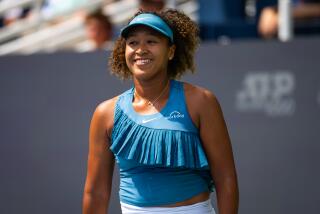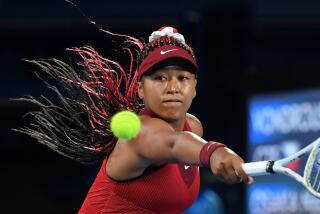Tennis player to the stars has still got game at 91
“What would you like to know about my sex life?”
Gene Mako, playfully greeting a visitor to his West Hollywood home, laughs as he poses the question. The mischievous former tennis champion, winner of four Grand Slam doubles titles in the 1930s and married since before the attack on Pearl Harbor, is 91 years old. His walker, stationed nearby, is ever present since he suffered a stroke 1 1/2 years ago. A full-time nurse provides round-the-clock care.
The years have slowed him, sure, but the Hungarian-born and Southern California-bred Mako still possesses the same sense of humor and engaging wit that ingratiated him to the Hollywood glitterati of his youth.
His many friends included Charlie Chaplin, Howard Hughes, Clark Gable, Fred Astaire, Bing Crosby, Bob Hope, Walt Disney, bandleader Jimmy Dorsey and jazz pianist Oscar Peterson. He built tennis courts for Ginger Rogers and Jack Nicholson. He says it was he who introduced Crosby to Hope.
As he recalls, “Bing and I were coming out of a restaurant ... “
Along the way, Mako surely must have shared stories with his famous pals of the day he stood in, improbably, as the last line of defense between Don Budge, his best friend and doubles partner, and the first Grand Slam in tennis history.
Improbably because two years before encountering Budge in the U.S. National Championship final at New York on Sept. 24, 1938, Mako suffered a shoulder injury that threatened to end his career, turning his once-blistering serves and emphatic overheads into cruel memories.
“Everybody said I had the best serve and overhead in the world,” Mako says. “And I went from that to nothing. Mentally, it was a terrible thing.”
Mako says that only a nudge from Budge, who persuaded the former USC star to continue as his doubles partner, kept him from quitting tennis. Together, Mako and Budge won Wimbledon doubles titles in 1937 and ‘38, even though Mako says he served “like an old lady,” striking the ball with a sidearm motion. They reached four consecutive U.S. championship finals starting in 1935, winning in ’36 and ‘38, and twice helped the U.S. win Davis Cup titles.
Mostly because of his successful partnership with Budge, Mako was inducted into the International Tennis Hall of Fame in Newport, R.I., in 1973.
But Mako, who won national collegiate singles and doubles titles as a USC sophomore in 1934, says he rarely played singles after injuring his shoulder in an awkward fall on a grass court in England in the summer of 1936.
So it was a surprise when, after a string of upsets, he reached the U.S. final in 1938, the first unseeded player in the tournament’s history to advance to the championship round. He had never before reached a singles final in a Grand Slam event, nor would he again.
Budge, meanwhile, was on the cusp of tennis history. The redhead from Oakland, who died in 2000, already had won the Australian, French and Wimbledon titles in 1938 and was heavily favored to become the first player to complete a sweep of all four of the sport’s major championships in the same year.
On the eve of the historic final, played a week later than scheduled because of persistent rain, Budge and Mako celebrated their semifinal victories earlier in the day by spending the evening together listening to jazz at Manhattan nightclubs. Buddies more than rivals, they were roommates on the road, sharing a hotel suite while in New York. And so Mako says it wasn’t the least bit awkward when Budge won the final in four sets, cementing his place in history.
Afterward, Mako says, they piled into Mako’s 1935 V-8 Ford and drove back to California, stopping only to play a couple of exhibitions in Chicago.
In winning the Grand Slam, a feat matched in men’s tennis history only by Rod Laver, Mako says that Budge “practically blew everybody away that year. He was a very natural talent who, in ’37 and ‘38, was more or less unbeatable.”
In hindsight, Mako notes, “Now that I’m an old geezer, I realize that it was a terrific accomplishment for me just to reach the final.”
He was only 22, but Mako happily gave up full-time tennis when Budge turned pro the next year. Before Mako was injured, he says, he and Budge split four head-to-head matches. But after his serve and overhead were taken from him -- “In those days, doctors couldn’t do what they can do today,” Mako notes -- the Southern Californian never again defeated his friend, losing “five or six times.”
Still, Mako says he never looked back. He served in the Navy during World War II, played professional basketball while stationed in Norfolk, Va., and briefly tried pro tennis. Later, he built successful businesses as an art dealer -- his father, Bartholomew, was an accomplished painter and sculptor -- and tennis-court builder. He and his wife, Laura, have been married nearly 66 years.
Whether Mako might have enjoyed a more successful career in singles if not for his bum shoulder is something he’ll never know, of course.
But he has a theory.
“Because I had to concentrate like a son of a gun after I was injured, maybe I would not have played any better, or even as well, if I hadn’t been injured,” he says. “I was a pretty happy-go-lucky guy and I was in very good shape, but I did not spend that much time working on my game.
“I did most everything I did with whatever talent I had.”
Alongside the dominating Budge, that was usually enough.
Against him, it was not.
More to Read
Go beyond the scoreboard
Get the latest on L.A.'s teams in the daily Sports Report newsletter.
You may occasionally receive promotional content from the Los Angeles Times.










